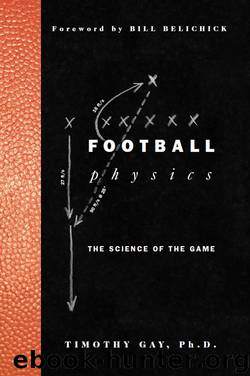Football Physics by Timothy Gay

Author:Timothy Gay
Language: eng
Format: epub
Publisher: Rodale Press
Published: 2004-03-15T00:00:00+00:00
BAD TO THE BOUNCE
There are a number of reasons why kickers want the ball to tumble end-over-end. The first has to do with something we’ve already considered: conservation of angular momentum. When the ball moves off the tee, it has two kinds of inertia. There’s the normal linear kind we learned about with the First Law. The mass of the football wants to go in a straight line. Of course it is dissuaded from following a straight-line path by the force of gravity. The second kind of inertia is the rotational kind. Conservation of angular momentum says that, unless acted upon by an external torque, an object will maintain its rate and orientation of spin. This tendency for a spinning ball to maintain its orientation is what stabilizes the tumbling ball in flight. This in turn improves a kicker’s ability to accurately place the ball where he wants it to go. (More on this in chapter 6.)
What are the other options? If our kicker puts the arc of his foot right through the ball’s center of mass, he won’t exert any torque on it to make it tumble. You might think that this will make the ball go faster, but it won’t. As long as the kicker de livers a given impulse to the ball, it doesn’t matter where he kicks it—the center-of-mass flight speed will always be the same. (The reason a ball kicked near one end won’t go very far is that it rotates out of the way before the kicker can really lay into it and deliver a big impulse.) Now the ball moves off the tee with no rotational motion. It thus has no angular momentum to stabilize it in flight. This means that it is very susceptible to air currents and temporary pressure instabilities that will cause it to fly through the air erratically, in much the same way a knuckleball does when thrown by a baseball pitcher. These small variations in trajectory can build up over time and significantly degrade the accuracy of the kick. On the other hand, the “knuckle” football can be used to good advantage when kicking the ball from deep in your own territory so that accuracy is not as important as distance and hang time. All Pro punter Craig Hentrich is famous for this kind of kick; it is very hard for the return man to figure out where the ball is going. This can throw off his timing, his catch, and his ability to get behind his blockers for the return.
The other problem with a nonrotating ball is that, leaving the tee with its long axis roughly perpendicular to its flight path, it experiences the maximum possible air drag. A tumbling ball will, over the average of a complete revolution, experience the average of the maximum and minimum drag forces. Drag can be reduced even more with a spiral punt, but this is next to impossible to pull off completely in placekicking. Pro punters can manage a rough spiral perhaps 80 percent of the time.
Download
This site does not store any files on its server. We only index and link to content provided by other sites. Please contact the content providers to delete copyright contents if any and email us, we'll remove relevant links or contents immediately.
The Complete Stick Figure Physics Tutorials by Allen Sarah(7334)
Secrets of Antigravity Propulsion: Tesla, UFOs, and Classified Aerospace Technology by Ph.D. Paul A. Laviolette(5330)
Thing Explainer by Randall Munroe(3905)
The River of Consciousness by Oliver Sacks(3569)
The Order of Time by Carlo Rovelli(3162)
How To by Randall Munroe(3074)
A Brief History of Time by Stephen Hawking(2990)
I Live in the Future & Here's How It Works by Nick Bilton(2957)
What If?: Serious Scientific Answers to Absurd Hypothetical Questions by Randall Munroe(2667)
The Great Unknown by Marcus du Sautoy(2661)
Midnight in Chernobyl by Adam Higginbotham(2515)
Blockchain: Ultimate Step By Step Guide To Understanding Blockchain Technology, Bitcoin Creation, and the future of Money (Novice to Expert) by Keizer Söze(2465)
Networks: An Introduction by Newman Mark(2382)
The Meaning of it All by Richard Feynman(2317)
Easy Electronics by Charles Platt(2304)
The Tao of Physics by Fritjof Capra(2247)
Midnight in Chernobyl: The Untold Story of the World's Greatest Nuclear Disaster by Adam Higginbotham(2195)
When by Daniel H Pink(2098)
Introducing Relativity by Bruce Bassett(2097)
